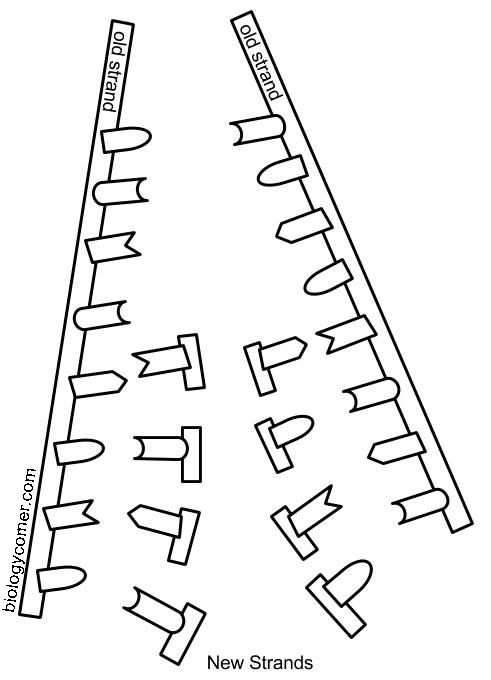<p>Picture a mesmerizing double helix twisting elegantly through the realm of our cells. It's the iconic DNA molecule, holding the blueprint of life itself. As we peer closer, we discover that this exquisite ladder comprises two sturdy sides—the backbone—crafted from alternating sugar and phosphate molecules. These sides serve as the framework upon which the genetic code, represented by nitrogenous bases, is meticulously anchored.</p>The Backbone: A Foundation of Sugar and Phosphate
<p>The sides of the DNA ladder are composed of alternating sugar and phosphate units. These units form a continuous chain, akin to a molecular backbone that supports the ladder's structure. The sugar component, deoxyribose, is a particular type of sugar molecule with a unique five-carbon ring. These deoxyribose molecules provide the backbone with its flexibility, allowing it to bend and fold into the iconic double helix shape.</p>
<p>Phosphate, an electrically charged molecule, forms the other half of the backbone. These phosphate groups link together through covalent bonds, creating a negatively charged backbone. This negative charge attracts positively charged molecules, including the nitrogenous bases that carry the genetic code. This electrostatic attraction holds the bases in place, creating the famous base pairs that make up the rungs of the DNA ladder.</p>Decoding the Components of the DNA Backbone
<p>Deoxyribose, the sugar component, consists of a five-carbon sugar ring with a hydrogen atom attached to the 2' carbon. This unique structure distinguishes deoxyribose from ribose, the sugar found in RNA molecules. The absence of the hydroxyl (-OH) group on the 2' carbon makes deoxyribose more stable and resistant to degradation, essential for the long-term preservation of genetic information.</p>
<p>Phosphate, the counterpart of deoxyribose, is a negatively charged molecule consisting of a phosphorus atom bonded to four oxygen atoms. These phosphate groups form the backbone's framework, linking the deoxyribose sugars together through covalent bonds. The negative charge of the phosphate groups allows DNA to interact with other molecules, such as proteins, and helps to maintain the structural integrity of the double helix.</p>Side Chains: Functional Extensions of the Backbone
<p>Attached to each deoxyribose sugar molecule is a nitrogenous base, the fundamental unit of genetic code. These bases—adenine (A), thymine (T), guanine (G), and cytosine (C)—form complementary base pairs, which determine the genetic sequence and provide the instructions for building and maintaining life.</p>
<p>The side chains, consisting of the nitrogenous bases, extend outward from the DNA backbone like branches on a tree. These side chains interact with each other through hydrogen bonds, forming the rungs of the DNA ladder. The specific sequence of base pairs along the DNA backbone carries the genetic code, determining the traits and characteristics of an organism.</p>Unraveling the Latest Discoveries in DNA Research
<p>The study of DNA continues to unravel groundbreaking discoveries, shaping our understanding of genetics and its implications for medicine, biotechnology, and beyond. Recent advancements include:</p>
<ul>
<li><strong>CRISPR-Cas9 Technology: </strong>A revolutionary gene-editing tool that enables precise changes to DNA sequences, offering promising applications in treating genetic diseases and developing new therapies.</li>
<li><strong>Personalized Medicine: </strong>The tailoring of medical treatments based on an individual's genetic profile, promising more effective and individualized healthcare.</li>
<li><strong>DNA Nanotechnology: </strong>The utilization of DNA's unique properties to construct tiny structures and devices, opening up possibilities in computing and novel materials.</li>
</ul>Expert Advice for Enhancing DNA Comprehension
<p>To delve deeper into the fascinating world of DNA, consider these expert tips:</p>
<ul>
<li><strong>Engage in Active Reading: </strong>Take notes and sketch diagrams while reading about DNA to facilitate understanding and retention.</li>
<li><strong>Visualize the Double Helix: </strong>Create a 3D model or build a virtual simulation of DNA using online tools for a better comprehension of its structure.</li>
<li><strong>Seek Clarification: </strong>Consult textbooks, articles, or online resources to clarify any uncertainties and expand your knowledge.</li>
</ul>Frequently Asked Questions About DNA
<ol>
<li><strong>Q: What is DNA?</strong>
<p><strong>A: </strong>DNA (deoxyribonucleic acid) is a molecule that contains the instructions for an organism's development and characteristics.</p>
</li>
<li><strong>Q: What does DNA look like?</strong>
<p><strong>A: </strong>DNA has a double helix structure, resembling a twisted ladder with two strands running parallel to each other.</p>
</li>
<li><strong>Q: What are genes?</strong>
<p><strong>A: </strong>Genes are segments of DNA that code for specific proteins and determine an organism's hereditary traits.</p>
</li>
<li><strong>Q: Can DNA be damaged?</strong>
<p><strong>A: </strong>Yes, DNA can be damaged by factors such as UV radiation, chemicals, and errors during DNA replication.</p>
</li>
<li><strong>Q: How is DNA repaired?</strong>
<p><strong>A: </strong>Cells have mechanisms to repair damaged DNA, such as DNA repair enzymes and recombination processes.</p>
</ol>Conclusion: Embracing the Intricacies of DNA
<p>The sides of the DNA ladder, fashioned from deoxyribose and phosphate molecules, provide the framework for life's intricate code. Understanding the structure and function of these sides empowers us with insights into the very essence of existence. As we continue to unravel the mysteries of DNA, we unlock profound potential for advancements in medicine, biotechnology, and our understanding of the world.</p>
<p>Are you intrigued by the molecular marvels of DNA? Share your thoughts and questions in the comment section below, and let's embark on a collective journey of discovery.</p>

Image: slideplayer.com

Image: www.biologycorner.com
What Is The Sides Of The Dna Ladder Made Of

